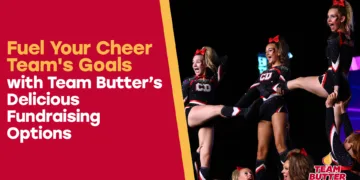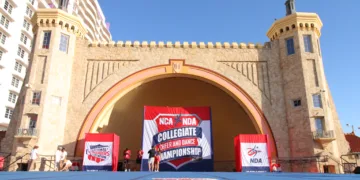Cheerleading has transformed over recent decades from spirited sidelines into a competitive, high-intensity sport requiring serious athleticism. With more than 3.5 million youth participants today, cheerleading demands rigorous skills, year-round training, and increasingly complex stunts, tumbling, and pyramids. As injuries in cheerleading continue to rise, the American Academy of Pediatrics (AAP) has issued a revised set of guidelines aimed at improving safety and minimizing injury risks for young athletes.
The October 2024 policy statement, led by Dr. Greg Canty and Dr. Jennifer King, represents the most comprehensive AAP guidelines yet, building on the initial 2012 recommendations. Here’s what the latest research tells us about cheerleading injuries, the recommendations from the AAP, and what cheer coaches, parents, and athletes can do to help keep the mat safe.
While the overall injury rate in cheerleading is lower than other high school sports, the injuries are often severe, requiring significant recovery time. Concussions are a primary concern, now accounting for 31% of all cheer injuries, a sharp increase from past figures. Falls during stunting and tumbling have resulted in head, neck, and spine injuries, with young athletes often out of the sport for three weeks or more following a concussion.
Beyond head trauma, injuries to the ankles, wrists, and arms are common, often stemming from high-risk moves like basket tosses, pyramids, and complex stunt formations. According to the National High School Sports-Related Injury Surveillance Study, cheer has a lower injury rate than other girls’ sports, such as soccer and basketball, but many cheer injuries are classified as “catastrophic”—meaning they involve severe, sometimes permanent damage. The policy highlights these serious risks and the urgent need for preventative measures to protect young cheer athletes.
AAP’s Recommendations to Boost Cheer Safety
The AAP has released an extensive list of recommendations covering everything from concussion protocols to the role of certified coaching, each aimed at minimizing injury risks for athletes. Here’s a breakdown of the key suggestions.
1. Certified Coaching & Enhanced Oversight
- The AAP advocates for oversight of all scholastic cheerleading programs by state athletic departments to ensure certified coaches, safe practice spaces, and regular injury reporting.
- Coaches should have certification in spotting techniques and proper stunt execution, ensuring that all technical skills are performed safely. Many stunts, such as partner lifts, pyramids, and tumbling, require careful monitoring and spotting to prevent accidents. The National Federation of State High School Associations (NFHS) and USA Cheer offer safety and risk management training for cheer coaches, which the AAP recommends as a standard certification.
2. Stringent Concussion Protocols
- Given the increase in concussion rates, the AAP emphasizes strict protocols to ensure safe return-to-play for injured athletes. Any cheerleader suspected of a concussion should be removed from participation immediately, with a formal clearance required before resuming training or competitions.
- Educating coaches, athletes, and parents on the signs of a concussion and the importance of rest and recovery is essential to prevent long-term health risks.
3. Safe Stunt Surfaces & Limitations on Heights
- The AAP underscores the importance of performing stunts on safe surfaces like mats, grass, or rubberized flooring, explicitly prohibiting skills on concrete, asphalt, or wet surfaces.
- For pyramids and other high stunts, height limits and the presence of certified spotters are crucial. Pyramids should not exceed two levels, and spotters are recommended for every stunt over shoulder height.
4. Emergency Preparedness
- Every cheer program, from school teams to all-star gyms, should have a documented Emergency Action Plan (EAP) for handling injuries. The plan should outline steps for rapid response and care for athletes who suffer an injury mid-routine.
- Regularly rehearsing these emergency procedures ensures all team members and staff are prepared to act quickly if a serious injury occurs.
5. Regular Preparticipation Evaluations (PPE)
- Cheerleaders should have routine evaluations before joining a team to assess their overall health, address any existing conditions, and ensure they are fit for the physical demands of cheer.
- Given the aesthetic pressures in cheer, the AAP also recommends that PPEs address body image and caloric intake, helping to prevent bone stress injuries and other health issues linked to body dissatisfaction.
Concussion Concerns in Cheerleading
Concussions are now a major focus in cheer injury prevention, given their rise in recent years. High school data shows that stunting and tumbling are the main culprits for head trauma, especially when contact with another athlete or the playing surface occurs. According to the AAP, bases and spotters are more likely to suffer concussions from other athletes, while flyers often hit the ground, underscoring the need for vigilance and spotting during stunts.
Cheerleaders who sustain concussions are often out for extended periods, and with injury reporting becoming more standardized, the real impact of these injuries is finally being documented. The AAP highlights the importance of educating coaches, athletes, and parents on concussion symptoms to facilitate early intervention and avoid long-term damage.
The Role of STUNT in Cheer’s Evolution and Safety Standards
STUNT, a head-to-head competitive format of cheer without the traditional crowd-leading role, has gained popularity and is reshaping cheer at the collegiate level. This discipline focuses exclusively on athleticism, meeting NCAA requirements for a sport, and has recently joined the NCAA Emerging Sports for Women Program at the Division II level, with potential future expansion to Divisions I and III.
As a competitive discipline, STUNT adheres to strict safety and training standards, making it a model for how cheer can evolve as a sport focused on skill and safety. The AAP’s policy statement notes STUNT’s potential to elevate safety standards across the cheer world, advocating for its growth as a safe, structured alternative.
Monitoring and Reporting Injuries
The policy statement points out the need for comprehensive injury reporting systems in cheerleading, especially as injuries often go unreported or are classified incorrectly. Many injuries occur at private gyms or community leagues rather than schools, and without standardized reporting, it’s difficult to get a full picture of cheer injury rates.
To address this gap, the AAP urges coaches, athletic departments, and cheer organizations to maintain accurate injury records and report any serious incidents to the National Center for Catastrophic Sport Injury Research. Increased transparency will help cheer organizations better understand injury trends, measure the effectiveness of safety rules, and guide further recommendations.
Beyond physical injuries, the AAP’s recommendations emphasize creating a safe and inclusive environment free from abuse, bullying, or harassment. They encourage every cheer team to have policies aligned with SafeSport, ensuring a positive atmosphere for athletes of all backgrounds. For athletes with disabilities, the AAP recommends engaging with programs like ParaCheer International, which provides accessible opportunities and specialized resources for disabled cheer athletes.
With the evolution of cheer into an internationally recognized sport and the recent IOC recognition of the International Cheer Union (ICU), cheerleading is poised for further growth on the global stage. USA Cheer, the national governing body, plays a key role in expanding cheer’s reach in North America, and its recent partnership with the U.S. Olympic and Paralympic Committee has the potential to bring cheer closer to Olympic inclusion.
STUNT, with its NCAA recognition and alignment with Title IX requirements, represents cheer’s leap toward competitive legitimacy, allowing cheer athletes to compete under NCAA safety standards. The AAP’s endorsement of STUNT highlights the discipline as a potential model for cheer’s evolution into a recognized collegiate sport.
The AAP’s latest policy statement represents a significant step toward ensuring that cheerleading is as safe as it is athletic. The recommendations aim to minimize risks, promote education on concussion and injury management, and foster a positive, inclusive environment for every athlete.
As the cheer community adapts to these guidelines, cheerleading stands to gain greater recognition, better safety standards, and more robust support systems. The recommendations from the AAP are a call to action for coaches, parents, athletic trainers, and cheer organizations to work together to keep young athletes safe on the mat.
Stay updated with Cheer Daily for more insights, news, and tips on injury prevention in cheer.






















